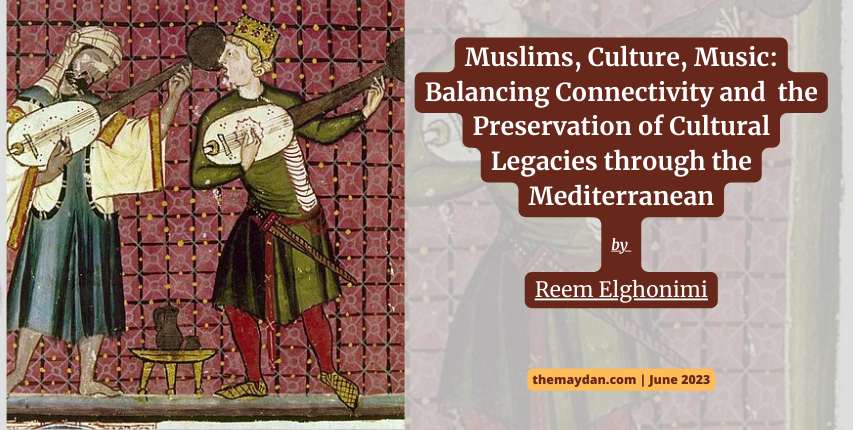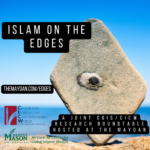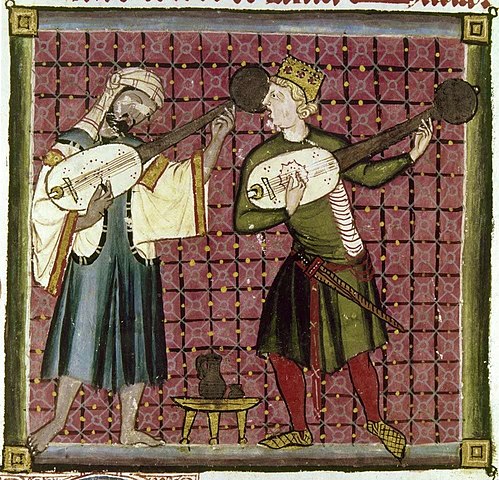
 This essay is part of the Islam on the Edges research portfolio hosted on the Maydan as a collaboration of the Center for Islam in the Contemporary World at Shenandoah University (CICW) and the AbuSulayman Center for Global Islamic Studies at George Mason University (CGIS). Learn more at themaydan.com/2022/01/edges/ and submit pitches to publish@themaydan.com.
This essay is part of the Islam on the Edges research portfolio hosted on the Maydan as a collaboration of the Center for Islam in the Contemporary World at Shenandoah University (CICW) and the AbuSulayman Center for Global Islamic Studies at George Mason University (CGIS). Learn more at themaydan.com/2022/01/edges/ and submit pitches to publish@themaydan.com.
In 1960, when legendary jazz trumpeter Miles Davis released the album Sketches of Spain (listen here), a stunning work of fusion which went on to win a Grammy Award, he unwittingly (but intuitively) bridged a cultural divide that has long dissuaded Americans from learning about or relating to Islam and the Muslim world. That era of jazz and blues harked back to a long-lost forebear—the Mediterranean’s Muslim musical culture. Consistently ranked among the top 400 greatest recordings of all time, Sketches featured a prominent arrangement of the slow, or adagio, second movement of the 1939 global phenomenon, the haunting guitar concerto known as Concierto de Aranjuez (listen to a recent interpretation in which the adagio starts at 9:30), written by the Spanish composer Joaquín Rodrigo. For Davis, a life-long interest in flamenco began with a performance his wife Frances insisted he attend. Before him, Rodrigo, too, suffused his art with that same genre, a Hispano-Arab legacy, bred from the Mediterranean’s North-West African and Spanish Muslim populations. Yet, the same tremor that runs through any modern discussion of Spain’s indebtedness to Arab-Islamic influence also appears in mainstream black American attitudes to Islam. Around the globe as well, politicization of the religion creates a vicious cycle in the domain of education. American social studies curricula, for instance, rarely venture to teach us about the cultures of the Muslim world, an omission that dissociates children from their cultural legacies and risks alienating Muslims.
For Davis, a life-long interest in flamenco began with a performance his wife Frances insisted he attend. Before him, Rodrigo, too, suffused his art with that same genre, a Hispano-Arab legacy, bred from the Mediterranean’s North-West African and Spanish Muslim populations.
Indeed, what is most conspicuous in Sketches and Aranjuez (and what eventually bound their fortunes together) is the survival of an artifact of Muslim culture and arts. As the late historian María Rosa Menocal asked, regarding the uncanny architectural resemblance between nineteenth-century New York synagogues and classical Islamic mosques, “Yet where are the stories in our education that reveal to us why this is so?”[1]
Because it has connected various people and places, the Mediterranean offers us the chance to piece together such stories. Nonetheless, the flip side of that connectivity is that certain narratives have been privileged over others for far too long. We know far less about Muslims (and their cultural achievements) as a result of West-centric history, whose weight and pull is undeniable even today when we are aware of the bias. Until we can fill that void with representative accounts of what transpired, such distortions will continue to plague us.
In other words, although we now know the study of arts and humanities goes a long way in correcting historical judgments based solely, and mistakenly, on political and religious dichotomies, it is still a rarity in historical investigations of Islam. Indeed, if we are “to reconfigure the map of Europe and put the Mediterranean at the center”, as Menocal advised, we must prioritize the arts.[2] To do that — to unearth the contributions of Islam and Muslim culture — recalls the act of archaeology. Like the latter, we first have to sift through the topmost and well-known shelves of human history before we are able to reach what we are after and what is unknown to us today.
Demonstrating how Mediterranean Muslim artistic culture linked the Spanish guitar piece and the American jazz album, then, begins with the composer Rodrigo’s story. Luckily, we have his own written account of his creative journey. In addition, what we know about his life and work indicates an immense regard for the past. For example, he mentions the concerto is named for the royal court and gardens known as the Palacio Real de Aranjuez. Over centuries, that site became a favored spring/summer residence for Spain’s nobility. In 1974 he reflected on why and how he chose the piece’s title:
It is named after the famous royal site on the shore of the River Tagus, not far from Madrid, along the road to Andalucia, and some perceive Goya’s shadow in the notes of its music, full of melancholy emotion. Its music seems to bring to life the essence of an 18th century court, where aristocratic distinction blends with popular culture.
In the midst of explaining the personal significance of Aranjuez, he locates it “along the road to Andalucia,” the southern-most region of the Iberian Peninsula in which Muslims and Maghrebi culture thrived for nearly eight hundred years. Hispano-Arabs were responsible for cultivating the folk tradition known as flamenco, associated with guitar music and dance (watch here), which, in turn, accommodated Iberian Romance tradition. In other words, his infusion of popular forms into an identifiably royal and classical setting, imports Spanish Muslim culture.

As for structure, Aranjuez comprised three movements, much like works from the classical period. The scoring for the first and last movements was upbeat and fast but the second flowed deliberately and sorrowfully. In a 1943 letter he described that creative process: “If the adagio and the final allegro transported me as if by inspiration. . . . I came upon the first movement by way of reflection, calculation, and willpower. This was the last of the three to be written, so I ended the work where it actually began.” It was the haunting adagio that Miles Davis later borrowed for his project, the movement he deemed more evocative of flamenco, and the one Rodrigo considered an inspired/immediate rather than a calculated/forced movement.
In terms of style, the piece interweaved high- and low-brow forms to embrace all Spanish traditions. Rodrigo explained this choice as “a synthesis of classical and popular in both form and emotion.” The eclecticism was not haphazard, however. As an intentional choice, he strove to inculcate both precision and agility. Because he found inspiration in the past and then strove to re-interpret and embody it within a modern framework, the composer is considered a neoclassicist.
Finally, as to the experience and meaning with which he invested Aranjuez as an imagined place, Rodrigo depicted them in the language of sensation: “[i]n its melody the perfume of magnolias linger, the song of birds and the whisper of fountains.” It has been pointed out that, in reality, Aranjuez was a rather bleak setting before the nobility lavished attention on it and transformed it into the beautiful Palacio Real de Aranjuez. In the wintertime, as it was at the time Rodrigo and his wife visited following their January 1933 wedding, the park would have been an uninviting destination. On the other hand, it must be remembered that the composer, besides being an admirer of rugged terrain, was blind. Young Joaquín lost his sight to diphtheria at the age of three. As a result, the sensory details he invokes (the perfume of magnolias, the song of birds, and the whisper of fountains) are non-visual perceptions of the imagination, not of physical reality. By describing what the Aranjuez park meant to him in the language of an almost mythical menagerie, one recalls, through his words, the animals, topiary, and statuaries the Hispano-Arabs built into the short-lived but wondrous palatial complex, Cordoba’s Madinat Zahra—one project among those Menocal names “the gardens of memory” produced by Iberia’s Muslims. Indeed, this connection is evident in Rodrigo’s 1974 reflections on Andalusia and folk music as crucial elements of his art.
To a large degree, Joaquín claimed that particular medieval heritage, along with Jewish scales and texts, and Catholic Baroque elements, for his project. Certainly, Andalusian flamenco’s signature lelelelo refrain (watch the singer El Lebrijano’s rendition) is a variation of Islam’s creed lā ilāha illa Allāh (there is no god but Allah). With the debut of Aranjuez and, later, its international acclaim, the maestro became known for an even closer link to Mediterranean Muslim artistic culture. Rodrigo became the first composer who made the guitar the star of an orchestral ensemble. Before Aranjuez, guitar masters could only perform transcriptions of classical piano pieces. In other words, no composer before Rodrigo wrote a guitar concerto, much less one that preserved a past conqueror’s folk traditions.
Even more telling than the appropriation of flamenco, this break with convention and focus on the guitar characterizes an undeniable link to Muslim Spain. According to Owen Wright, more than in any other area of musical influence (music theory, notation, or rhythm), Hispano-Arab and North-West African musical instrumentation accounted for
a significant proportion of the medieval European instrumentarium…made up of instruments either directly of Spanish-Arab provenance or sufficiently affected by contact with similar types used in Muslim Spain for the Arabic name to be adopted in place of the indigenous one.[3]
This is certainly true for the rabāb, whose bowing and holding technique against the chest led to the viol, and it is especially the case for the plucked four-stringed Arabic ‘oūd, which came to be known as guitarra morisca in Latin.[4] That aspect of the medieval Mediterranean is evident in the thirteenth-century Cantigas de Santa Maria image, depicted at the beginning of this essay, of a Muslim and a Christian musician playing the same stringed instrument side-by-side.
Finally, a word must be said about Rodrigo’s relationship with his wife, Victoria de Kamhi. Their lifelong professional collaboration began in 1927, when the two met and fell in love in Paris, where Kamhi, a pianist from Türkiye, studied music. When they married in 1933, she retired from professional performance. From then until she died in 1997, Kamhi participated in every part of her husband’s career. Most authorities on the composer’s life agree she was the single most influential force on his work and, specifically, that her Jewish heritage was an important source for Rodrigo’s stylistic choices and techniques.
While that opinion is undoubtedly true, few observers, however, have noticed the vital connectivity Islam forged in the couple’s marriage as well. This aspect of their relationship sheds light on why the husband and wife duo decided to quote from Hispano-Arab culture for the acclaimed 1939 guitar concerto. The answer lies in how the two artists, from such different backgrounds, found one another in the first place, and that has to do with Kamhi’s identification as a Sephardi.
Sephardic Jews, by definition, originally hailed from Spain. That national tie ended in 1492, however, when the Reconquest of Spain, led by the Catholic monarchs Isabella and Ferdinand, forced Spanish Jews (numbering in the hundreds of thousands) to choose between conversion to Christianity or immediate expulsion. As Sephardim, her ancestors had fled the Catholic Reconquest and accepted the asylum granted by the Ottoman Empire. In Istanbul, the port of Sultan Bayazid II opened in 1492 to welcome refugee ships departing Iberia. Most importantly, Kamhi’s knowledge of her origins meant that, for nearly five hundred years, her family had both retained the identity of Spaniards and, yet, had chosen to remain in Türkiye, the nation that provided them sanctuary.
On the other hand, for nearly 800 years on the Iberian Peninsula, Muslim rule had provided Sephardic Jews undeniable grounds to claim Spain as ancestral land. Muslim sovereigns, as a rule, neither compelled Jews to change their religion nor displaced them from their homes.
In a poignant way, then, Islamic civilization, both in the past (Spain) and present (Türkiye), exercised a potent if silent role in the union between Rodrigo, a Catholic Spaniard, and Kamhi. Their subsequent return to Spain, therefore, brought a centuries-long forced migration from ancestral homeland to an end. The couple’s adoption of Muslim folk art into Spanish classical and popular music, then, suggests their appreciation of Islamic civilization’s hidden yet profound role in uniting them across the divide of their faiths.
The couple’s adoption of Muslim folk art into Spanish classical and popular music, then, suggests their appreciation of Islamic civilization’s hidden yet profound role in uniting them across the divide of their faiths.
On that basis, the Concierto de Aranjuez’s dedication to Arab-Islamic culture may very well have been a shared commitment, as true for Victoria Kamhi as it was for Joaquín Rodrigo. As it took place during the late 1930s amid the throes of the global economic depression and Spain’s descent into fascism and civil war, this homage was rather defiant. Since their professional partnership must have peaked in the strenuous period associated with writing Aranjuez, which was the highlight of Joaquín’s career, the conscious adoption and channeling of Muslim folk art into Spanish popular culture suggest the couple appreciated the universal dignity and acceptance that Muslim Spain and the Ottoman Empire had extended. This mediation characterizes what may be the most powerful dimension of Mediterranean Islam, in the sense that it worked to bring together even non-Muslim sub-cultures in the West.
This mediation characterizes what may be the most powerful dimension of Mediterranean Islam, in the sense that it worked to bring together even non-Muslim sub-cultures in the West.
Certainly, the completion of Aranjuez culminated in the highest point of Rodrigo’s artistic life and earned him a role in reviving an indelibly neoclassical Spanish identity for the modern era. It is undoubtedly one of the most played and beloved guitar masterpieces of all time. Ironically, when asked about his reasons for admiring the past, Rodrigo is said to have answered that he was “faithful to a tradition” with no further specification.
As to the artist who both transformed and carried the Spanish legacy forward, Miles Davis (and the efflorescence of jazz) first had to confront American attitudes to the genre that ranged from ridiculing it as a “retrogression” to regarding it as a music for “the lover of sensuous and debasing emotions.”[5] Whereas jazz first made inroads through blues, ragtime, and folk music, by the 1950s and 60s the line between high- and low-brow forms had vanished. For instance, Duke Ellington spurned the idea that his profession did not encompass jazz and classical. At the point Davis made his mark on jazz, the distinction was a relic of the past. And yet, Sketches of Spain became a model for showcasing how to cohere these various components, so that the album was hailed as “one of the most memorable works to come from popular culture in the 20th century.” With a full orchestra and jazz ensemble accompanying him, Davis, on a flügelhorn, coaxed a new sound for the era through his solos. Notably, whereas Rodrigo stopped short of divulging exactly what “tradition” he followed, Davis was more explicit in his autobiography (although he left the politicized element of religion, namely, Islam, out of his remarks):
You’ve got all those Arab music scales up in there, black African scales that you can hear. . . there was a little bit of the same thing, the same kind of voice that I played on the trumpet in ‘Solea.’ ‘Solea’ is a basic form of flamenco . . . It’s close to the American black feeling in the blues. It comes from Andalusia, so it’s African-based.
Clearly, the two artists’ musical tastes and productions leaned substantively on Andalusian/ Mediterranean Muslim culture and arts. For his part, Rodrigo allotted to each portion of the musical past a due respect in Concierto de Aranjuez. However, by elevating the guitar to a central position in his break with classical European conventions, his composition reveals a certain selectivity. In his choice to preserve North/West African and Hispano-Arab musical lineages as a popular culture able to resist a sterile classicism, Joaquín Rodrigo may have signaled, after all, to which musical tradition he was faithful. Of course, this example of ambiguity in crediting Islam as a source of artistic inspiration is only one of many. Today it highlights a rather noxious tendency to efface a cultural influence that would otherwise make available the educational resources needed to teach new generations about their cultural legacies, thereby teaching them how to preserve and tell their own vibrant stories and reclaim their unique histories.
Reem Elghonimi is an independent researcher based in Austin, Texas, United States. Her research focuses on epistemology, the arts, the history of philosophy and science, and human rights in the Islamic world and its points of connection with Western thought and history. She completed her MA in Islamic Law, which was awarded with Distinction, from Islamic College London. In addition, she holds an MA in History from The University of Texas at Austin as well as an MA in Humanities from The University of Texas at Dallas. Her research languages are Arabic and Spanish.
Reem’s MA thesis focused on the theology of qaḍāʾ wa qadar (the question of fate and free will) in three Muslim legal scholars’ work: al-Shāfi‘ī, Ibn Ḥazm, and an-Nawawī. She has a recent essay “Deceit, the Imagination, and Personal Discernment: Ibn Khaldūn and Occult Causation” published by The Islamic College in 2023 as part of the Proceedings of the Seventh Annual International Conference on Shi‘i Studies.
[1] María Rosa Menocal, Ornament of the World: How Muslims, Jews, and Christians Created a Culture of Tolerance in Medieval Spain (New York: Little, Brown and Company, 2002), 10.
[2] Menocal, Ornament, 11.
[3] Owen Wright, “Music in Muslim Spain,” in The Legacy of Muslim Spain Vol 2, Ed by Salma Khadra Jayyusi (Leiden: Brill, 1992), 566.
[4] Wright, “Music”, 566.
[5] Lawrence W. Levine, “Jazz and American Culture,” The Journal of American Folklore 102, no. 403 (1989): CII, 11-12.

